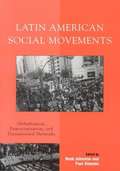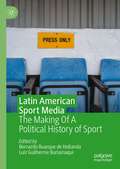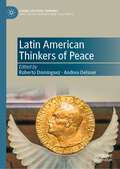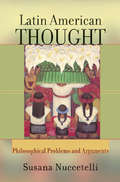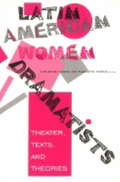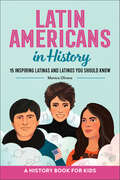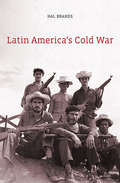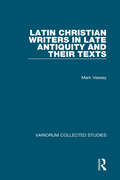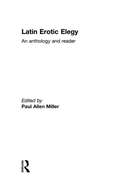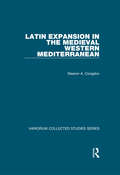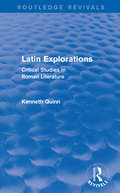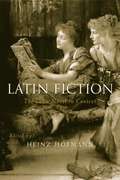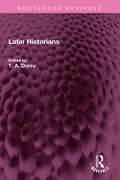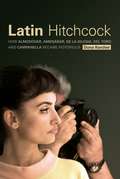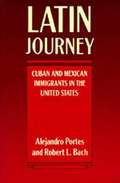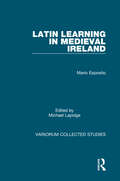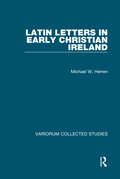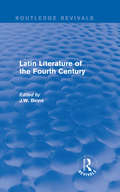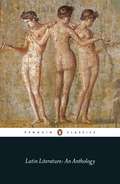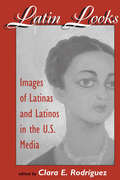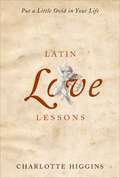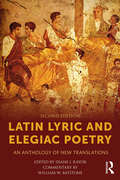- Table View
- List View
Latin American Social Movements
by Paul AlmeidaAs Johnston (social psychology and social change, San Diego State U.) and Almeida (sociology, Texas A&M U.) observe, Latin America has experienced an unprecedented wave of popular protest in the last decade, a phenomenon they argue is not fully explainable by reference to economic grievances and social claims. Their characterization of the new social movements find a fuller explanation in the intersection of three themes: neoliberal economic globalization and its effect on the articulation of claims, democratization and the opening of political opportunities for challenging groups, and networks of advocacy and support organized on a transnational scale. They present 13 case studies that explore these themes, individually and in combination, as they have manifested in Mexico, Argentina, Venezuela, El Salvador, Nicaragua, Brazil, and Guatemala. Annotation ©2006 Book News, Inc., Portland, OR (booknews.com)
Latin American Soldiers: Armed Forces in the Region's History (Latin American Tópicos)
by John R. BawdenIn this accessible volume, John R. Bawden introduces readers to the study of armed forces in Latin American history through vivid narratives about four very different countries: Mexico, Cuba, Brazil, and Chile. Latin America has faced many of the challenges common to postcolonial states such as civil war, poorly defined borders, and politically fractured societies. Studying its militaries offers a powerful lens through which to understand major events, eras, and problems. Bawden draws on stories about the men and women who served in conventional armed forces and guerrilla armies to examine the politics and social structure of each country, the state’s evolution, and relationships between soldiers and the global community. Designed as an introductory text for undergraduates, Latin American Soldiers identifies major concepts, factors, and trends that have shaped modern Latin America. It is an essential text for students of Latin American Studies or History and is particularly useful for students focusing on the military, revolutions, and political history.
Latin American Sport Media: The Making Of A Political History of Sport
by Bernardo Buarque de Hollanda Luiz Guilherme BurlamaquiThis book provides an historical overview of the formation of sports media in Latin America and its role in the construction of the political history of Latin American sport. The sports press was a privileged observer of the development of modern sports, but it was also a key factor in the making of professional sports in Latin America. Most of the literature on sport in Latin America treats the sports press as an historical source, rarely taking it as an object of study in itself. However, the development of sports in the region is connected to national and state-building processes and the role of media narratives is crucial to understanding how sports participate in those processes. Spanning the globalization of football in the late nineteenth century to the shift promoted by television in the 1970s, the chapters survey the historical development of sports media in Latin America. Representing ten countries, the contributors follow a framework that presents the press not as a passive narrator of the sports phenomenon, but as a social agent of the sports field. This book is of use to those interested in the history of sports and the media, and it will be a good resource for undergraduates taking courses on Sports History, Latin American History, Sports Management, and Journalism and Communication.
Latin American Thinkers of Peace (Global Political Thinkers)
by Andrea Oelsner Roberto DomínguezThis book analyzes seven Latin American thinkers who have contributed to building bridges for reconciliation and peace: Carlos Saavedra Lamas, Adolfo Pérez Esquivel, Alfonso García Robles, Óscar Arias Sánchez, Rigoberta Menchú Tum, Juan Manuel Santos, and Javier Pérez de Cuéllar. Working within an eclectic conceptual approach to systematize the circulation of ideas embraced by each one of the thinkers, the various contributions delve into the current literature of leadership and intellectuals in Politics and Global International Relations (GIR). Overall, the central premises of the analysis are based on three fundamentals of mainstream constructivism: a) change across time and space in the lifetime of each thinker under analysis in this book; b) socialization through changing norms, rules, and language; and c) processes of interaction in which actors make choices in selecting networks and strategies). Coming from different walks of life, the seven thinkers examined in this book have accessed the global public square and discussed ideas to reduce conflicts at different scales. In their respective historical times, they circulated their views and ideas beyond the confines of Latin America to influence global political thought and produce change in favor of peace.
Latin American Thought: Philosophical Problems and Arguments
by Susana NuccetelliMany of the philosophical questions raised in Latin America may seem to be among the perennial problems that have concerned philosophers at different times and in different places throughout the Western tradition, but they are not altogether the same--for Latin American thinkers have often adapted them to capture problems presented by new circumstances, and sought resolutions with arguments that are indeed novel. This book explains how well-established philosophical traditions gave rise in the New World to a characteristic form of thought not to be found in other cultures. There was no clean sweep of the past and an attempt to start over: rather, Latin American thinkers gradually adapted European ideas to their needs, sometimes borrowing on a larger scale, sometimes less. It is then no surprise that, under Iberian rule, Scholasticism became the accepted view and began to lose its grip only when the rulers did. But what does seem surprising is the radical way in which those traditions were on occasions challenged, as illustrated by the cases of José de Acosta, a Jesuit priest in Peru, and the Mexican nun, Juana Inés de la Cruz-each of whom spoke out against certain aspects of the official philosophy in colonial society. And when theories familiar elsewhere arrived to Latin America, as in the cases of positivism and Marxism, they were often seen differently in the light of new circumstances. But above all, this book shows that there is a body of interesting philosophical arguments offered by Latin Americans concerning problems that have arisen in Spanish- and Portuguese-speaking parts of the New World. In connection with this purpose, it examines how Latin Americans have thought about philosophical issues belonging to metaphysics, philosophy of science, cross-cultural psychology, feminist epistemology, ethics, and social and political philosophy. These are taken up in due course, paying special attention to questions of rationality, gender discrimination, justice, human rights, reparation for historically dispossessed native peoples, and relativism vs. universalism--all matters of continuing concern in Latin American thought, from its earliest stirrings to the present day. And among some specific issues that have generated heated controversies from the early twentieth century to the present, the book explores how Latin Americans and their descendants abroad think of their own cultural identity, examines their critique of US mass-culture and moral philosophy, and considers at some length the vexing problem of which name, if any, is the correct one to use to refer to all of this exceedingly diverse ethnic group. A closer look at the defining elements of Latin American identity has often led to questions concerning the characteristic features that might distinguish Latin Americans and their descendants abroad from other peoples of the world, the existence of a typically Latin American philosophy, and the correct name to refer to them. These, often conflated in the literature, are treated separately by the author, who favors a historically-based account of Latin-American identity. She also argues that the existence of a characteristically Latin American philosophy can be shown-though not by appealing to some standard but implausible reasons. And to resolve the question concerning a correct ethnic-group name, she proposes a new approach to the semantics of those names.
Latin American Women Dramatists: Theater, Texts, and Theories
by Catherine Larson and Margarita Vargas&“This thoughtfully crafted . . . insightful and informative [anthology] elucidates an overlooked, essential component of the Latin American literary canon&” (Choice).Latin American Women Dramatists sheds much-needed light on the significant contributions made by these pioneering authors during the last half of the twentieth century. Contributors discuss fifteen works of Latin-American playwrights, delineate the artistic lives of women dramatists from countries as diverse as Argentina, Brazil, Chile, Mexico, Puerto Rico, and Venezuela. Looking at these writers and their work from political, historical, and feminist perspectives, this anthology also underscores the problems inherent in writing under repressive governments.&“The book highlights the many possibilities of the innovative work of these dramatists, and this will, it is to be hoped, help the editors to achieve one of their other key goals: productions of the plays in English.&” —Times Literary Supplement, UK
Latin Americans in History: 15 Inspiring Latinas and Latinos You Should Know (Biographies for Kids)
by Monica OliveraAmazing stories of Latin Americans who changed the world—for kids ages 8 to 12Discover the incredible contributions that people of Latin American heritage have made to world history! Learn about Simón Bolívar, a Venezuelan soldier who helped many South American countries achieve independence from Spain. Meet Violeta Barrios Torres de Chamorro, a former journalist and the first female president of Nicaragua. And get to know Gloria Estefan, the Cuban singer and songwriter who became the "Queen of Latin Pop." From politicians and physicists to poets and painters, these biographies explore 15 incredible Latin American people who used their creativity, intelligence, and strong beliefs to improve the world around them. Detailed biographies—Dive deep with stories that cover each person's entire life, including their childhood, their accomplishments, and the challenges that they faced. Learn and grow—These impressive people will inspire you to discover your own talents and use them to achieve your dreams and support your community. Beyond this book—Want to learn more? Each biography includes activity ideas and suggestions for further reading so you can keep exploring. See how much there is to know about influential Latin Americans from all backgrounds with th is Latino children's book.
Latin America’s Cold War
by Hal BrandsFor Latin America, the Cold War was anything but cold. Nor was it the so-called “long peace” afforded the world’s superpowers by their nuclear standoff. In this book, the first to take an international perspective on the postwar decades in the region, Hal Brands sets out to explain what exactly happened in Latin America during the Cold War, and why it was so traumatic. Tracing the tumultuous course of regional affairs from the late 1940s through the early 1990s, Latin America’s Cold War delves into the myriad crises and turning points of the period—the Cuban revolution and its aftermath; the recurring cycles of insurgency and counter-insurgency; the emergence of currents like the National Security Doctrine, liberation theology, and dependency theory; the rise and demise of a hemispheric diplomatic challenge to U.S. hegemony in the 1970s; the conflagration that engulfed Central America from the Nicaraguan revolution onward; and the democratic and economic reforms of the 1980s. Most important, the book chronicles these events in a way that is both multinational and multilayered, weaving the experiences of a diverse cast of characters into an understanding of how global, regional, and local influences interacted to shape Cold War crises in Latin America. Ultimately, Brands exposes Latin America’s Cold War as not a single conflict, but rather a series of overlapping political, social, geostrategic, and ideological struggles whose repercussions can be felt to this day.
Latin Biography (Routledge Revivals)
by T. A. DoreyFirst published in 1967, Latin Biography contains chapters on Nepos, Plutarch and Suetonius, the three best-known Classical biographers. There are also accounts of the less-familiar works of Q. Curtius Rufus and the author – or authors – of the Historia Augusta, and three chapters deal with the development of Latin biography in the Middle Ages. The Middle Ages were indebted to Suetonius, Shakespeare to Plutarch, Gibbon to the Historia Augusta. Since the Renaissance their methods have gradually been superseded by a more critical and scientific approach, but the ancient biographers can always claim the credit for having established biography as a major form of literature. This book will be of interest to students of literature and classical studies.
Latin Christian Writers in Late Antiquity and their Texts (Variorum Collected Studies)
by Mark VesseyBy close engagement with both traditional and contemporary approaches to ancient Christian literature, Latin Christian Writers in Late Antiquity and their Texts seeks to delineate a historiographical problem, at the same time rendering patristics as part of the subject-matter of a new literary history. After preliminary essays marking out the field, the volume is organized in three sections by authors, forms of discourse, and disciplines. Released from the theological discipline of patristics, the writings of the church fathers have in recent decades become the common property of students of early Christianity, late antiquity and the classical tradition. In principle, they are now no more (nor less) than sources, documents and literary texts like others from their period and milieux. Yet when replaced in the longer history of Western textual and literary practices, the collective literary oeuvre of Latin clerics, monks and ascetic freelances of the Later Roman Empire may still seem to occupy a place of decisive, if not canonical importance. How does one now account for the abiding formativeness of Latin Christian writing of the fourth and fifth centuries CE? What demands does such writing lay on a modern history of literature? These are the questions asked here, in view of a new literary history of patristic texts.
Latin Erotic Elegy: An Anthology and Reader
by Paul Allen MillerThis indispensable volume provides a complete course on Latin erotic elegy, allowing students to trace a coherent narrative of the genre's rise and fall, and to understand its relationship to the changes that marked the collapse of the Roman republic, and the founding of the empire.The book begins with a detailed and wide-ranging introduction, looking at major figures, the evolution of the form, and the Roman context, with particular focus on the changing relations between the sexes. The texts that follow range from the earliest manifestations of erotic elegy, in Catullus, through Tibullus, Sulpicia (Rome's only female elegist), Propertius and Ovid.An accessible commentary explores the historical background, issues of language and style, and the relation of each piece to its author's larger body of work. The volume closes with an anthology of critical essays representative of the main trends in scholarship; these both illuminate the genre's most salient features and help the student understand its modern reception.
Latin Expansion in the Medieval Western Mediterranean (The Expansion of Latin Europe, 1000-1500)
by Eleanor A. CongdonWhile Latin expansion stalled in the Eastern Mediterranean in the late Middle Ages, Islam lost ground to Christendom in the west - in the Spanish Levant, the islands of the Western Mediterranean, and even on the Maghribi coast, where conquerors and colonists from the northern shore of the sea established footholds. Edited by Eleanor Congdon, with an introduction by Felipe Fernández-Armesto and James Muldoon, this collection of classic studies illuminates the problems of how the expansion occurred and why it was slow and limited. The volume broaches fundamental questions of Mediterranean history formulated by Henri Pirenne and Fernand Braudel. The place of the late medieval Western Mediterranean in the history of the sea as a whole and of European overseas expansion generally emerges with new clarity, as the reader re-traces the process of formation of one of the world’s great frontiers between civilizations. Important work by Maria Teresa Ferrer i Mallol appears in translation for the first time, alongside pieces by such leading authorities as David Abulafia, Robert I. Burns, S.J., Miguel Angel Ladero Quesada, and Hilmar C. Krueger.
Latin Explorations: Critical Studies in Roman Literature (Routledge Revivals)
by Kenneth QuinnLatin Explorations, first published in 1963, offers a fresh approach to Roman poetry from Catullus to Ovid. Traditionally, the period is divided for specialist studies – Lyric, Epic and Elegy. In each of them, techniques of interpretation prevail, isolated from contemporary ideas about poetry and dominated by barriers between ‘textual’, ‘exegetical’ and ‘aesthetic’ criticism. Kenneth Quinn discerns in Roman poetry of this period the adolescence, maturity and decay of a single coherent tradition whose internal unity surpasses differences of form. His argument attempts to reverse the dissociation of purely academic research from appreciative criticism, whilst also incorporating the work of textual scholars. Each chapter is supported by a detailed analysis of the texts: nearly 700 lines of poetry are discussed and translated. Latin Explorations will be of significant value not only to students of the Classics, but also to the ‘Latinless’ general reader who is interested in Roman literature.
Latin Fiction: The Latin Novel In Context
by Heinz HofmannLatin Fiction provides a chronological study of the Roman novel from the Classical period to the Middle Ages, exploring the development of the novel and the continuity of Latin culture. Essays by eminent and international contributors discuss texts including: * Petronius, Satyrica and Cena Trimalchionis* Apuleius, Metamorphose(The Golden Ass) and The Tale of Cupid and Psyche* The History of Apollonius of Tyre* The Trojan tales of Dares Phrygius and Dictys Cretensis* The Latin Alexander* Hagiographic fiction* Medieval interpretations of Cupid and Pysche, Apollonius of Tyre and the Alexander Romance. For any student or scholar of Latin fiction, or literary history, this will definitely be a book to add to your reading list.
Latin Historians (Routledge Revivals)
by T. A. DoreyFirst published in 1966, Latin Historians gives an account of some of the most important Latin historians. There are chapters on Caesar, Sallust, Livy and Ammianus Marcellinus, together with an account of earlier historians, and on Polybius, the Greek who had much influence on the Roman World. Bede, the earliest of the great Christian historians in England, is also discussed. This book will be of interest to students of history, literature and classical studies.
Latin Hitchcock: How Almodóvar, Amenábar, De la Iglesia, Del Toro and Campanella Became Notorious
by Dona KercherThis study explores how five major Spanish and Latino directors modeled their early careers on Hitchcock and his film aesthetics.
Latin Hitchcock: How Almodóvar, Amenábar, De la Iglesia, Del Toro, and Campanella Became Notorious
by Dona KercherThis study explores how five major directors—Pedro Almodóvar, Alejandro Amenábar, Alex de la Iglesia, Guillermo del Toro, and Juan José Campanella—modeled their early careers on Hitchcock and his film aesthetics. In shadowing Hitchcock, their works embraced the global aspirations his movies epitomize. Each section of the book begins with an extensive study, based on newspaper accounts, of the original reception of Hitchcock's movies in either Spain or Latin America and how local preferences for genre, glamour, moral issues, and humor affected their success. The text brings a new approach to world film history, showcasing both the commercial and artistic importance of Hitchcock in Spain and Latin America
Latin Journey: Cuban and Mexican Immigrants in the United States
by Alejandro Portes Robert L. BachLatin Journey details an eight-year study of Mexican and Cuban immigrants to the U.S.
Latin Learning in Medieval Ireland (Variorum Collected Studies)
by Michael Lapidge Mario EspositoThe field of Hiberno-Latin literature, a term coined to describe the Latin literature written in Ireland, or by Irishmen abroad, between 400 and 1500, was first defined by the late Mario Esposito. His work, too, revealed its vast extent and range, so enabling a significantly better understanding of the importance of Irish scholarship in the cultural history of the Western Middle Ages. This volume concentrates on Hiberno-Latin authors, and on texts composed in Ireland; a second collection of Esposito’s articles contains studies on Irish learning and texts written on the Continent. The great strength of his research is that it is founded on unparalleled knowledge of the manuscripts - many of which, indeed, no longer survive. The articles, now provided with extensive indexes to facilitate their consultation, therefore form the essential basis and guide for any further enquiry into the authors dealt with or their works.
Latin Letters in Early Christian Ireland (Variorum Collected Studies)
by Michael W. HerrenThis book is concerned with the transmission and reception of Latin literary culture in the early Middle Ages, and with the production of Latin works in Ireland and in Irish centres on the Continent. In these articles, Professor Herren deals with several closely related themes: the introduction of Latin into Ireland and the study of Latin literary heritage; the language and metre of Hiberno-Latin writings; and questions of dating and authorship pertaining to a number of crucial texts, from Columbanus to John Scottus Eriugena.
Latin Literature of the Fourth Century (Routledge Revivals)
by J. W. BinnsThis volume, offering an insight into the literary world of Rome in the fourth century AD, reflects an increased interest in the writers of the 150 years before the collapse of the Western Empire, who have long been over-shadowed by the pre-eminence accorded since the eighteenth century to the Golden and Silver ages. Among the writers examined are Ausonius, the poet, Imperial official and tutor to Gratian; Claudian, the last major ‘classical’ poet; Prudentius, and Paulinus of Nola, two of the founders of Christian Latin poetry; Symmachus, the letter writer and supporter of die-hard paganism; and St. Augustine, whose influence on Christian thought and the Middle Ages is incalculable. These essays consider how such writers responded to a world where vitality was ebbing from the old forms of political life, religion and literature, giving way to new institutions, modes of life and horizons of reflection.
Latin Literature: An Anthology
by Michael GrantA classic introduction to Latin literature, with translations of the best passages from Virgil, Livy, Ovid, Seneca and many others.This classic anthology traces the development of Latin literature from the early Republican works of Cicero and Catullus, to the writers of the Empire such as Lucan and Petronius, to the later writings of St Augustine. The selections cover comedy and epic, history and philosophy, in prose and in verse, and each passage is prefaced by an introduction to the author and his influence. The translators range across history from Alexander Pope and Lord Byron to contemporaries. The result is a broad and brilliant overview of the civilization of Rome and its Empire - an ideal introduction to Latin literature.Michael Grant was born in 1914. He served as an intelligence officer during the Second World War, and subsequently held academic posts at the universities of Cambridge, Edinburgh, Khartoum and Belfast. Over his lifetime, he published nearly fifty books on the ancient world, ranging from studies of Roman coinage, to biographies of Caesar, Nero and Jesus, to books on Ancient Israel and the Middle Ages. Many of his translations were published in Penguin Classics. Professor Grant moved to Italy in 1966, where he spent most of the rest of his life until his death in 2004.
Latin Looks: Images of Latinas and Latinos in the U.S. Media
by Clara E RodriguezWhat are “Latin looks”? A Latin look may seem at first blush to be something that everyone recognizes—brunette, sensual, expressive, animated, perhaps threatening. But upon reflection, we realize that these are the images that are prevalent in the media, while the reality in Latino communities is of a rich diversity of people and images. This book brings together a selection of the best, the most interesting, and the most analytically sophisticated writing on how Latinos have been portrayed in movies, television, and other media since the early years of the twentieth century and how images have changed over time in response to social and political change. Particular emphasis is given to representations of class, gender, color, race, and the political relationship between the United States and Latin America. Together the essays offer a corrective lens for interpreting how images are created, perpetuated, and manipulated.
Latin Love Lessons: Put a Little Ovid in Your Life
by Charlotte HigginsIt wasn't just heated floors, hot baths, aqueducts, and paved roads that the Romans did first and best—they were also experts at the art of love. From the most effective pickup lines to percipient advice on getting over a breakup, from grooming tips to sex tips, the Romans had time-proof solutions. Charlotte Higgins brings them together in this indispensable guide to love—a collection of the richest, most illuminating, and sensuous writing about this mysterious emotion that can move us to joy or despair.Filled with the sage advice of Catullus, Virgil, Horace, Ovid, Propertius, and Tibullus, this witty, smart, and laugh-out-loud-funny handbook offers a fresh, new take on romance based on some of civilization's oldest adages.
Latin Lyric and Elegiac Poetry: An Anthology of New Translations (Reference Library Of The Humanities #Vol. 1425)
by Diane J. Rayor William W. BatstoneLatin Lyric and Elegiac Poetry, first published almost 25 years ago, offered students accurate and poetic translations of poems from the sudden flowering of lyric and elegy in Rome at the end of the Republic and in the first decades of the Augustan principate. Now updated in this second edition, the volume has been re-edited with both revised and new translations and an updated commentary and bibliography for readers in a new century, ensuring that this much-valued anthology remains useful and relevant to a new generation of students studying ancient literature and western civilization. The volume features an expanded selection of newly translated poetry including: fresh Catullus translations, with a greater selection including Poem 64 fresh Sulpicia translations and the five poems of the "Garland of Sulpicia" six new Propertius poems new and revised selections from Tibullus, Ovid and Horace. The second edition reflects changing interests and modes of reading while remaining true to the power of the poetry that has influenced the literature of many cultures. The combination of accurate and vibrant translations with thorough commentary makes this an invaluable anthology for those interested in poetry, world literature, Roman civilization, and the history of ideas and sexuality, allowing readers to compare different poets' responses to politics, love and sex, literary innovation, self, and society.
